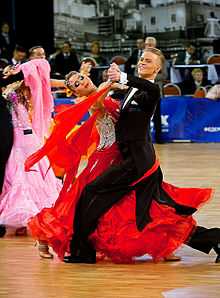Waltz (International Standard)

Waltz is one of the five dances in the Standard (or Modern) category of the International Style ballroom dances. It was previously referred to as Slow Waltz or English Waltz.
It is a Waltz dance and danced to slow, preferably 28-30 bars per minute (84-90 beats per minute),[1] [2] waltz music. Preferably, the 1st beat of a measure to be accented. Waltz music is in 3/4 time.
Most of the basic figures have 1 step per 1 beat, i.e. 3 steps per measure. Advanced figures may have 4-6 steps per measure, and this, coupled with various turns, makes the dance very dynamic despite the relatively slow tempo. At the same time, advanced dancers often use slow steps and elegant poses to create contrast (sometimes referred to as "light and shade").
Waltz is usually the first dance in the Dancesport competitions in the "Standard" category.
The dance is danced exclusively in the closed position, unlike its American Style counterpart.
Like all dances of Standard category, it is a progressive dance.
Waltz is characterized by the pendulum swing body action. Other general elements of ballroom technique important for Waltz are foot parallelism, rise and fall, contra body movement and sway.
Timing: 3/4; Beat: 28-30 measures per minute; Count: "1 - 2 - 3" (with an accent on "1"); Danced competitively since: 1923-1924.
It originated from the dances of several different peoples in Europe but its main predecessors were the "Matenick" and a variation called the "Furiant" that were performed during rural festivals in the Czech Republic. The French dance, the "Walt", and the Austrian Ländler are the most similar to the waltz among its predecessors.
The king of dances acquired different national traits in different countries. Thus there appeared the English Waltz, the Hungarian Waltz, and the Waltz-Mazurka.
The "Waltz" is derived from the old German word "walzen" meaning "to roll, turn", or "to glide". Nowadays the dance has three main forms:
Syllabus
Beginners
- Closed Changes
- Natural Turn
- Reverse Turn
- Natural spin turn
- Whisk
- Chasse from Promenade Position
Pre-Bronze
- Closed Impetus
- Hesitation Change
- Outside Change
Bronze
- Reverse Corte
- Back Whisk
- Basic Weave
- Double Reverse Spin
- Reverse Pivot
- Back Lock
- Progressive Chasse to Right
Silver
- Weave from PP
- Closed Telemark
- Open Telemark
- Wing
- Drag Hesitation
- Open Impetus
- Drag Hesitation
- Outside Spin
- Turning Lock
Gold
- Left Whisk
- Contra Check
- Closed Wing
- Turning Lock
- Fallaway Reverse
- Fallaway Whisk
- Hover Corte
See also
References
External links
| |||||||||||||||||